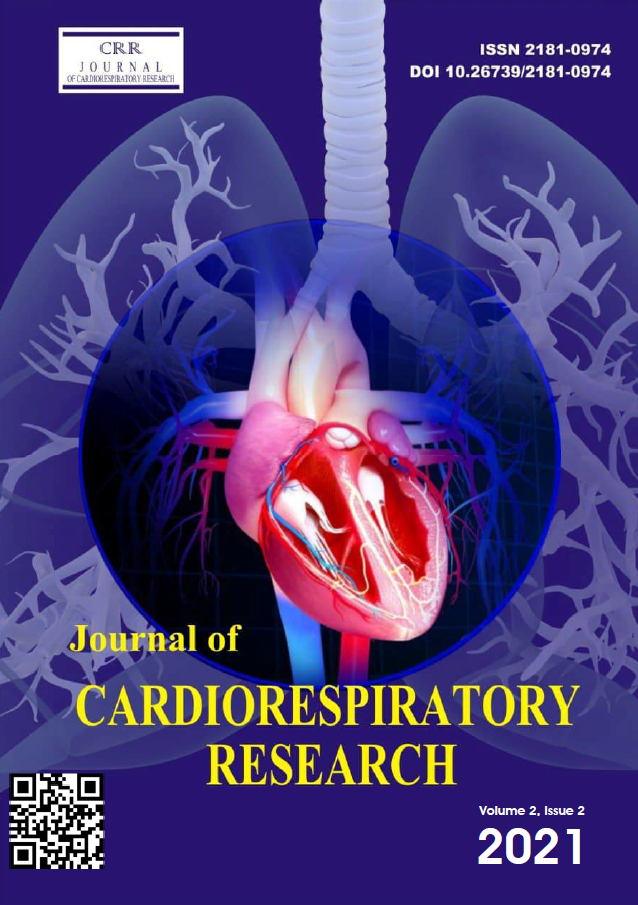МЕХАНИЗМЫ КАРДИОЗАЩИТНЫХ ЭФФЕКТОВ ДЕСФЛУРАНА И СЕВОФЛУРАНА ВО ВРЕМЯ РЕПЕРФУЗИИ
Ключевые слова:
десфлуран, севофлуран, реперфузия, посткондиционирование, прекондиционирование, реперфузионное повреждение, искусственное кровообращениеАннотация
Кондиционирование миокарда на самом деле является важной стратегией лечения ишемического реперфузионного повреждения. Концепция посткондционирования
анестетика интригует, его действие происходит в ключевой момент (реперфузия, когда инициируются ишемические реперфузионные поражения), когда активация этих кардиозащитных механизмов может пересилить механизмы, приводящие к ишемическим реперфузионным повреждениям. Десфлуран и севофлуран - летучие анестетики, часто используется во время кардиохирургии. В этом обзоре основное внимание уделяется эффективности десфлурана и севофлурана, вводимых во время ранней реперфузии, как потенциальной кардиозащитной стратегии. Механизмы, лежащие в основе кардиозащитного действия этих агентов и их способность вызывать посткондиционирование, были подробно рассмотрены, подчеркивая роль генерации активных форм кислорода, активацию клеточных сигнальных путей и действие на митохондрии. Этого вполне может быть достаточно, чтобы ожить основу для запуска рандомизированных клинических исследований, действительно необходимых для подтверждения того, что эта стратегия имеет реальное влияние.
Библиографические ссылки
A Araszkiewicz, M Grygier, M Pyda, J Rajewska, M Lesiak, S Grajek
Postconditioning attenuates early ventricular arrhythmias in patients with high-risk ST-segment elevation myocardial infarction. J Cardiol, 65 (2015), pp. 459-465
A Khan, A Binabdulhak, Y Alastal, et al. Cardioprotective role of ischemic post-conditioning in acute myocardial infarction : a systematic review and meta-analysis
Am Hear J, 168 (2014), pp. 512-521
A Zangrillo, V Testa, V Aldrovandi, et al. Volatile agents for cardiac protection in noncardiac surgery: a randomized controlled study. J Cardiothorac Vasc Anesth, 25 (2015), pp. 902-907
C Kikuchi, S Dosenovic, M Bienengraeber Anaesthetics as cardioprotectants - translatability and mechanism Br J Pharmacol, 172 (2015), pp. 2051-2061
D Obal, S Dettwiler, C Favoccia, H Scharbatke, B Preckel, W Schlack
The influence of mitochondrial KATP-channels in the cardio-protection of preconditioning and post-conditioning by sevoflurane in the rat in vivo Anesth Analg, 101 (2005), pp. 1252-1260
J Zhang, C Wang, S Yu, et al. Sevoflurane post-conditioning protects rat hearts against ischemia-reperfusion injury via the activation of PI3 K/AKT/mTOR signalling
Sci Rep, 4 (2014), p. 7317
JL Guerrero Orriach, MG Ortega, MR Aliaga, P Iglesias, MR Navarro, J Mañas
Prolonged sevoflurane administration in the off-pump coronary artery bypass graft surgery: beneficial effects. J Crit Care, 879 (2013), pp. e13-e18
J Hellström, A Öwall, CR Martling, P Sackey. Inhaled Isoflurane Sedation During Therapeutic Hypothermia After Cardiac Arrest: A Case Series Crit Care Med, 42 (2014), pp. 161-166
G Landoni, F Guarracino, C Cariello, et al. Volatile compared with total intravenous anaesthesia in patients undergoing high-risk cardiac surgery: a randomized multicentre study. Br J Anaesth, 113 (2014), pp. 955-963
KA Kortekaas, A van der Baan, LP Aarts, et al. Cardiospecific sevoflurane treatment quenches inflammation but does not attenuate myocardial cell damage markers: a proof-of-concept study in patients undergoing mitral valve repair. Br J Anaesth, 112 (2014), pp. 1005-1014
MV Cohen, JM Downey Combined cardioprotectant and antithrombotic actions of platelet P2Y12 receptor antagonists in acute coronary syndrome: just what the doctor ordered. J Cardiovasc Pharmacol Ther, 19 (2014), pp. 179-190
M Zaugg, E Lucchinetti Letter by Zaugg and Lucchinetti regarding article, “Randomized comparison of sevoflurane versus propofol to reduce perioperative myocardial ischemia in patients undergoing noncardiac surgery”. Circulation, 127 (2013), pp. e875-e876
N Jivraj, F Liew, M Marber Ischaemic post-conditioning: cardiac protection after the event
Anaesthesia, 70 (2015), pp. 598-612
SG De Hert, PJ Van der Linden, S Cromheecke, et al. Cardioprotective Properties of Sevoflurane in Patients Undergoing Coronary Surgery with Cardiopulmonary Bypass Are Related to the Modalities of Its Administration Anesthesiology, 101 (2004), pp. 299-310
S Lemoine, L Zhu, G Beauchef, et al. Signaling pathways involved in desflurane-induced post-conditioning in human atrial myocardium in vitro. Anesthesiology, 109 (2008), pp. 1036-1044
ZQ Zhao, JS Corvera, ME Halkos, et al.
Inhibition of myocardial injury by ischemic post-conditioning during reperfusion: comparison with ischemic preconditioning. Am J Physiol Heart Circ Physiol, 285 (2003), pp. H579-H588
YL Zhang, YT Yao, NX Fang, CH Zhou, JS Gong, LH Li Restoration of autophagic flux in myocardial tissues is required for cardio-protection of sevoflurane post-conditioning in rats. Acta Pharmacol Sin, 35 (2014), pp. 758-769
V Barsukevich, M Basalay, J Sanchez, et al. Distinct cardio-protective mechanisms of immediate, early and delayed ischaemic post-conditioning Basic Res Cardiol, 110 (2015), p. 452
YT Yao, DH Liu, LH Li Comparison of cardio-protective effects induced by different modalities of sevoflurane conditioning in isolated rat hearts. Perfusion (2015)
Advance Access published on June 9, pii: 0267659115590833

